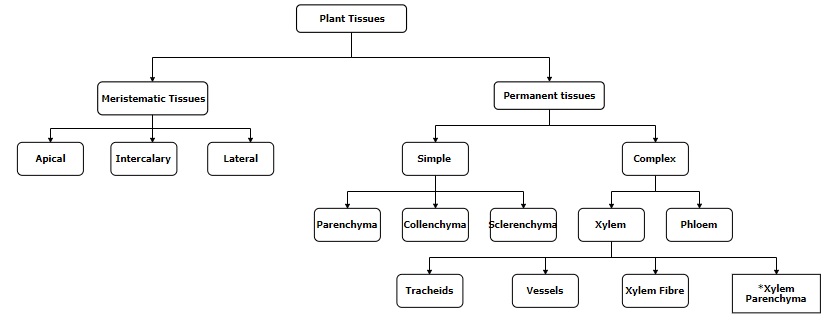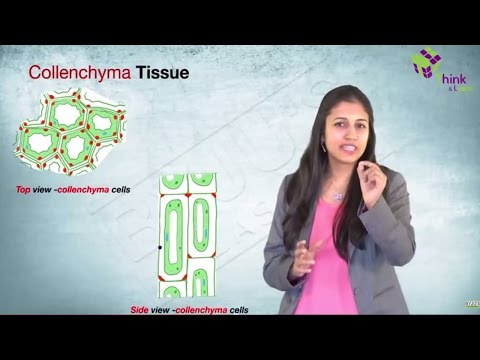“Xylem parenchyma is an element of complex tissue called “Xylem”. Parenchyma cells of xylem are mainly involved in the storage of carbohydrate, fats and water conduction.”
Download Complete Chapter Notes of Anatomy of Flowering Plants
Download Now
Table of Contents
Plant Tissues
Plant tissues can be categorised based on their structure and functions performed.


Plant tissues are classified into two types:
Meristematic tissues:
Cells which perform cell division and are responsible for the growth of the plants. There are of 3 types of meristematic tissues based on the regions they are present in plants:
- Apical meristems: It is a primary meristem that is present at the tip of root and shoot. It is responsible for an increase in the length of plants
- Intercalary meristems: Primary meristem which is present between mature tissues
- Lateral meristems: Secondary meristem, which grows later than primary meristem and helps plants grow laterally and produce secondary tissues
| Don’t miss: NEET Answer Key |
Permanent tissues:
They are differentiated cells, which are specialised to carry out a specific function. They generally don’t divide further and attain definite form and size. Permanent tissues are of two types:
- Simple tissues: have only one type of cells (homogeneous), which have a similar structure and function
- Parenchyma: It is a living tissue. Cells have a thin wall of cellulose. They perform functions like photosynthesis, secretion and storage
- Collenchyma: Present below the epidermis in dicot stem. Cells are thick at the corner due to cellulose and pectin deposition. They provide mechanical support to the plants at the time of growth
- Sclerenchyma: Long, narrow dead cells having thick walls of lignin. They provide mechanical support to organs
- Complex tissues: Heterogeneous, have many types of cells. Phloem and Xylem constitute the complex tissue in plants
- Phloem: Phloem consists of companion cells, phloem parenchyma, sieve tube elements and phloem parenchyma. Phloem transports food from leaves to various parts of the plant
- Xylem: Xylem consists of tracheids, xylem fibres, vessels and xylem parenchyma. It conducts water to various parts of the plant from roots
| Also check: Difference Between Parenchyma and Collenchyma Cells |
Xylem
Xylem originates from the Greek word “xylon” that means wood. Carl Nägeli coined the word xylem. Xylem is a type of vascular tissue present in plants, which primarily transports water and nutrients from roots to stem and leaves. They also provide mechanical strength to the plants.
On the basis of origin, there are two types of xylem cells:
- Primary xylem: originating from procambium, further divided into protoxylem and metaxylem
- Secondary xylem: originating from the vascular cambium
Xylem is composed of four different kinds of elements:
- Tracheids: Dead, tube-like cells with a tapering end. They are present mostly in gymnosperm and lower angiosperm. They have a thick lignified wall and lack protoplasm. Their main function is water and mineral transportation.
- Vessels: They are present in angiosperms. These are a long cylindrical structure having tube-like appearance. The walls are lignified and have a large central cavity. They are also dead and lack protoplasm. They have many cells called vessel members which are interconnected through a perforation in common walls. Mostly involved in the conduction of water, minerals and give mechanical strength to the plant.
- Xylem Fibre: Dead cell with lignified walls and a central lumen. Involved in water transportation and providing mechanical support.
- Xylem Parenchyma: Only living cells of xylem and store starch and fat. They assist in the short distance transportation of water.
Structure of Xylem Parenchyma
Parenchyma cells associated with xylem are called “xylem parenchyma”.
There are two major types of parenchyma cells in secondary xylem
- Axial parenchyma cells arranged around the axis
- Radial parenchyma cells arranged like a ray, radiating out of the common centre

The main characteristics of xylem parenchyma are:
- Only living cells of xylem
- The cell wall is cellulosic and thin
- They have prominent nucleus and protoplast
- Cells are colourless and have large vacuoles
- Living parenchyma cells are found in both primary and secondary xylem
- Fat and storage protein contents of parenchyma cells vary seasonally
- Crystal containing parenchyma cells have lignified walls with secondary thickening may be subdivided by septa
- In herbaceous plants and young twigs of woody plants, chloroplasts occur in xylem parenchyma cells, particularly in ray parenchyma cells
- Both axial and ray parenchyma cells which are present beside vessels form outgrowths called “tyloses”
- The parenchyma cells that give rise to tyloses are termed as “contact cells”
- Nucleus and cytoplasm of xylem parenchyma cells migrate into tyloses
- Tyloses store a variety of substances and may develop secondary walls
- Some tylose might differentiate into sclereids
| Also read: |
Functions of Xylem Parenchyma
The main functions of xylem parenchyma include:
- Storage of food material in the form of starch, fats, tannins and crystals
- Radial conduction of water takes place by the ray parenchymatous cell
- Xylem parenchyma cells are closely connected to vessels or tracheids through outgrowths called tyloses
- During drought or infection, these tyloses help to prevent damage to vascular tissues
- Xylem parenchyma cells are involved in the maintenance of xylem transport capacity
- They are responsible for the restoration of vessels and tracheids functionality when there is blockage of the cavity due to the air bubble (embolism). Cavitation occurs due to the high tension of water in the xylem tissues
Frequently Asked Questions on Xylem Parenchyma
What are parenchymal cells and their function?
Parenchyma cells are thin-walled, living cells, that are isodiametric in shape. They form major ground tissues in plants. Parenchyma cells are undifferentiated cells, which are highly adaptable and modified to perform various functions.
The main functions performed by parenchyma cells are the following:
- Photosynthesis by mesophyll cells present in the leaves
- Parenchyma cells function as a storage for water, starch, proteins, fat etc.
- Provide buoyancy to floating plants
- They perform short-distance transport of solute
- Parenchyma cells also have a secretory function, e.g. nectaries, salt glands
- Thick-walled parenchyma cells provide rigidity and strength to the plant
- Parenchyma present in the roots absorb water and minerals from the soil
- Parenchyma cells help in gaseous exchange
- Parenchyma cells give protection as a spiny projection in gymnosperm
- Cuticle present on epidermis reduces water loss by transpiration
- Parenchyma cells help in regeneration and healing under stress
How many different types of parenchyma cells are present in the plant?
There are seven main types of parenchyma cells found in plants. These are differentiated according to their location and functions performed
1. Chlorenchyma: present in mesophyll cells and differentiated into spongy and palisade tissue. They have chlorophyll and perform photosynthesis.
2. Aerenchyma: these cells have large intercellular space and present in aquatic plants. They help in gaseous exchange and provide buoyancy.
3. Vascular parenchyma: these are present in vascular tissue. The xylem contains xylem parenchyma and the phloem contains phloem parenchyma. It acts as a storage for food, starch, latex, fats, etc. Xylem parenchyma helps in radial conduction of water and helps in healing and regeneration under water stress condition.
4. Prosenchyma: these are thick-walled elongated cells, which give rigidity and strength to the plant.
5. Conjunctive parenchyma: forms root hair or thin epiblema in the young root and helps in the absorption of water and minerals from the soil.
6. Armed parenchyma: present as spiny projections in the leaves of some gymnosperms. They have a protective function.
7. Medullary parenchyma: they act as food and water reservoir, e.g. store starch in potato tubers, water storage in succulent plants.
What is Xylem made of?
Xylem is a complex tissue. Xylem is composed of 4 elements: tracheids, vessels, xylem parenchyma and xylem fibres. Vessels are not present in gymnosperms.
What are the types of xylem?
The xylem is of two types, primary xylem and secondary xylem.
1. Primary xylem: the first formed primary xylem is called protoxylem and later formed primary xylem is metaxylem. There are two types of organisation of primary xylem:
- Endarch- present in the stem, protoxylem is towards pith and metaxylem is towards the periphery
- Exarch- present in the roots, metaxylem in the centre and protoxylem towards the periphery
2. Secondary xylem: these are formed due to the action of the vascular cambium and responsible for an increase in the girth of the plant. The cells that cut off towards pith mature into secondary xylem. The two types of secondary xylem formed during spring and autumn constitute an annual ring.
What is the main function of xylem?
The main function of the xylem is water transport from roots to the other parts of the plant. Xylem also provides mechanical strength. Tracheids and vessels are the main elements for conducting water. Xylem fibres provide mechanical support and xylem parenchyma stores food materials and tannins and also conducts water radially.
Stay tuned to BYJU’S to learn more about xylem and other plant tissues.
Also Check:
NEET Flashcards: Plant Kingdom
NEET Flashcards: Morphology Of Flowering Plants
NEET Flashcards: Anatomy Of Flowering Plants
NEET Flashcards: Transport In Plants
NEET Flashcards: Mineral Nutrition

it really helped me well
It helped me a lot thanks.
Helped a lot, thank you
I read by byjus